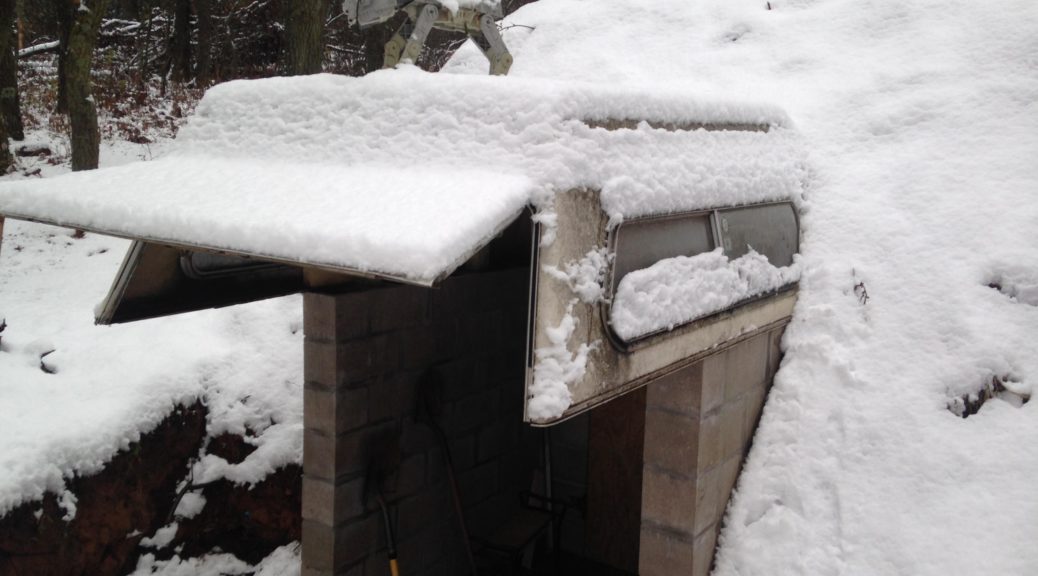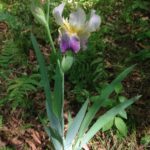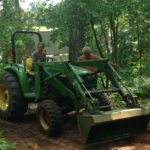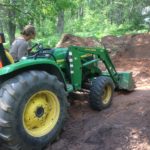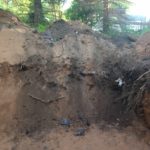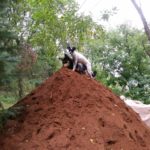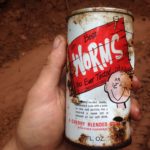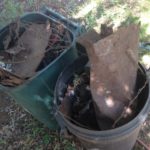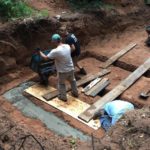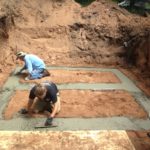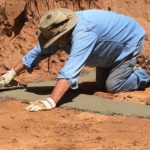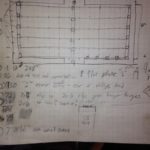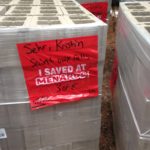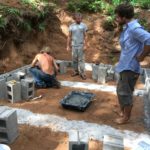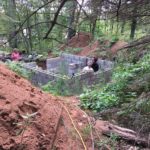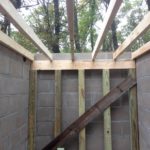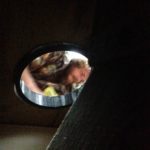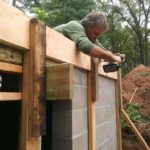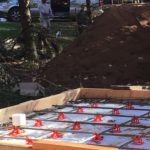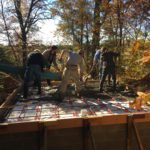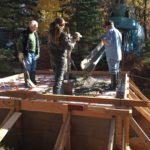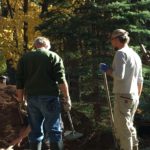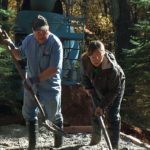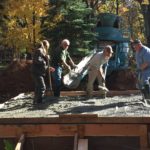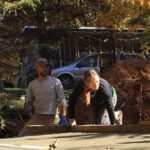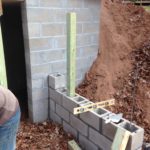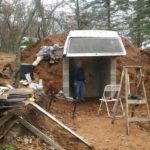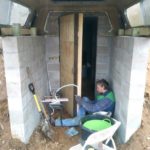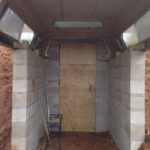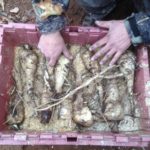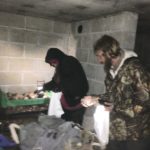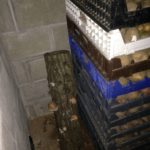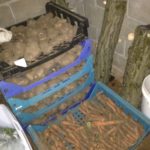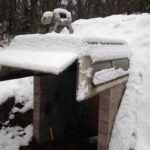Although the field has been frozen and dead for months now, we’ve been enjoying meals from it every day – we had kale that was indistinguishable from fresh-picked in December, and we’re enjoying perfect potatoes, carrots, beets, shiitake mushrooms, parsnips, cabbages, peppers, onions, leeks, cilantro, and parsley – all pulled as needed from the the cool humidity of our newly-completed root cellar.
There are some details to be completed still – the ventilation pipes need finishing, and the onset of hard freezes happened before we could build out the shelving or the internal door between the two rooms – but it’s likely always going to be a work in progress, like everything else here on the farm. It’s being used, and working as intended – so, done enough!
Click through the photo gallery to see how it was built …
We were awarded a grant from WWOOF-USA’s Small Farm Grant Program that helped cover a good chunk of the construction expenses – as part of it, they required that we submit a 3 minute video … so here it is for your viewing pleasure! Sorry about the awful lyrical pun.
… and if you’re really curious, here’s the grant proposal we submitted – if we hadn’t received it, I really don’t know if we would have gotten the project off the ground!
Project Proposal
As an off-grid farm, we face unique challenges in vegetable production at every step of the process.
The storage of harvested crops has been a significant obstacle, without access to the modern convenience of electric refrigeration. We have handled this as best we can for the past four years by leaving root crops in the field until ready to eat or sell them, harvesting in the early morning the same day as farmers markets and CSA deliveries, time-intensive and time-sensitive canning, avoiding crop rotations that require mass harvesting, and through cooperation with an on-grid neighbor.
We seek a more efficient and sustainable, less energy-intensive and wasteful method of food storage.
Rather than connect to the electric company or attempt to build an off-grid version of the modern solutions used by other farms in our area (i.e. a walk-in refrigerator powered by a much larger solar panel/battery system), we are looking at the age-old methods used by traditional agriculturalists across times and cultures – using the stable temperatures and moisture of the Earth itself to keep the food we grow fresher, longer.
Toward this end, our research has led us to an earthen-floored root cellar, to be built on the wooded slope near our field. This will allow us to harvest when weather and growth dictate, and store crops protected from temperature extremes, precipitation, desiccation, animals, insects, and decay until they are to be used.
Project goals:
- Creation of a 12×12’ two-room root cellar with required temperature and humidity provided by the earth, appropriate for the off-grid short and long-term storage of crops grown on our farm
(the front room will provide a drier storage space which is cooler in winter and warmer in summer. The variation between sections allows for better storage conditions for different crops.)- During severe thunderstorms and tornadoes, the root cellar will serve as storm shelter for farmers and WWOOFers.
- Follow best practices and design considerations from the book “Root Cellaring: Natural Cold Storage off Fruits and Vegetables” by Mike and Nancy Bubel
The Que Sehra Farm Root Cellar furthers WWOOF-USA’s mission:
- By working with next year’s WWOOFers to build the root cellar, and with future WWOOFers to work with the root cellar (storing fresh produce, making meals using root-cellared produce, monitoring and adjusting stored food, etc.) the Que Sehra Farm root cellar will serve to re-connect all who live, work, and eat on our farm to a pre-industrial practice found across cultures. This provides an ongoing educational exchange, reviving knowledge of essentially lost cultural practices to the young farmers of the future.
The Que Sehra Farm Root Cellar will benefit:
- Kristin and Gabe Sehr as farmers and homesteaders, and our growing community of WWOOFers, shareholders, family, friends, neighbors … our tribe, striving to reduce our dependence upon systems which we’d prefer not to support or engage with. We will be able to produce more in our small field by harvesting storage crops as soon as they reach maturity and using the freed up space to plant another succession of crops. We will provide fresh food for our community later into the fall and winter, a major goal for our short growing season.
- The experience we gain in root cellaring (principles, construction, use, maintenance) with be shared with WWOOFers for many years to come, and we all will bring that with us as we travel through the world to other WWOOF farms.
- Finally, our root cellar will serve as a storm shelter for ourselves and our hosted WWOOFers. We currently have no safe space to go in the event of a tornado; the trailer homes and simple shacks that we and our guests stay in are notoriously dangerous in severe weather. This is not an insignificant concern; in our state we average 30 tornadoes each year, and many more severe thunderstorms. In 2015 we had a WWOOFer suffer a full-on panic attack when a big thunderstorm came through. I’m writing this proposal while WWOOFing in south-central Georgia, where two days of tornadoes have just killed over a dozen people in the vicinity – and we were grateful for the brick structures our host farm had for us to shelter within. Storm safety is a meaningful secondary benefit that a root cellar would provide for us, as a WWOOF host farm.
The Que Sehra Farm Root Cellar will affect positive change:
- By making off-grid, organic farming more economically viable, more labor-efficient, and sustainable, and by serving as an example of how this can be done for others who wish to avoid the costs and burdens of dependence upon the power grid.
- By making it possible for us to bring a significantly greater quantity and quality of organic produce to our network of local food consumers.
Que Sehra Farm Profile
Kristin and Gabe Sehr both live and work full time on our farm from early March through late November with the help of WWOOFers, and when our land freezes, we WWOOF throughout the southern United States on other organic farms, learning new approaches & networking with like-minded people.
Our farm is on a small parcel of Sehr family land, which had been used previously for camping and hunting. With what we grow on the land, we feed ourselves, our WWOOFers, and a 25-member CSA, as well as sell produce through our local farmers market, and wholesale to local restaurants. We keep just over 1 acre in outdoor vegetable production, in addition to a 70×30’ high tunnel greenhouse, various perennial and fruit trees, and mushroom cultivation logs. We value the uncultivated areas as wildlife habitat.
Que Sehra Farm is not connected to the utility grid; our water comes from our well, our heat from the red oak trees that grow on most of our land, and our electricity needs are met by our modest solar energy system. Although we are not certified and are not interested in becoming so, we grow organically. We focus on low input methods. We hand pick pests, weed with hand tools, rotate crops for disease prevention, and apply abundant amounts of organic mulch and compost.
2017 will be our fourth year of hosting WWOOFers on our farm. When we started in 2013, WWOOFers had to sleep in tents, and we barely had enough solar power to run the lights. We’ve made many improvements since then, but still work, eat, and live side by side with the WWOOFers who come here.
We have hosted over twenty WWOOFers through the program, and plan on continuing to serve as hosts for the foreseeable future – from our first conception of radical lifestyle change, WWOOF has been the central pillar making it all possible – living simply without expensive winters or employees, forming a shifting tribe living in mutually-beneficial cooperation, depending on one another more than corporations and government.
We plan to remain small scale – avoiding the increased debt and expense that scaling-up is accompanied by. We plan to remain off grid, and continue to focus more on how we can thrive with less money, rather than how to make more, as is the standard path in our culture. A root cellar will provide security for us as homesteaders who grow as much of our own food as possible, and as farmers who earn our living from the land.
